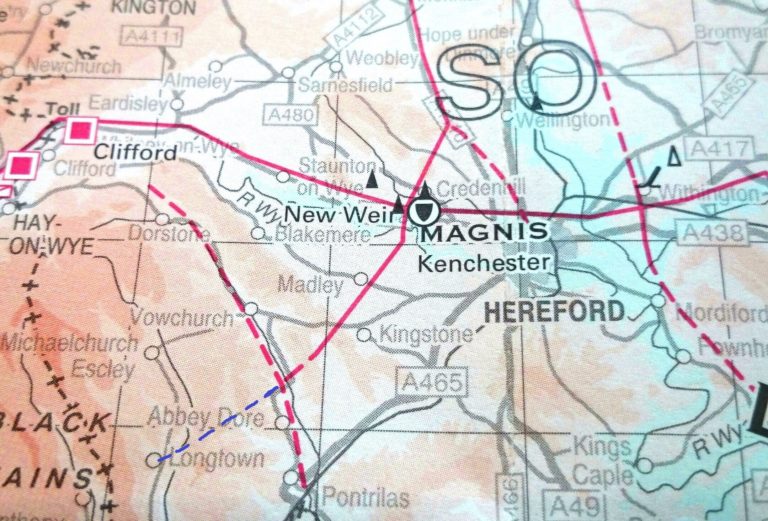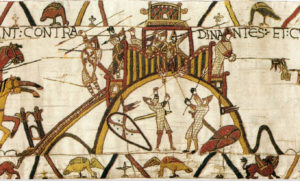The earliest possible history for the castles has revolved around the tradition that the outer rampart of Longtown Castle is Roman in origin. This belief has been supported in part by the fact that the well-established Roman road (Stone Street) running south-west from Magnis (modern Kenchester) on the Wye west of Hereford, appears to point towards Longtown.

Blue line indicates possible route
The road, in fact, ends today at Bacton, but straight stretches of road between there and Longtown, for example at Lower Maescoed, are highly suggestive to some of a Roman origin. One of the principle aims of the project is to test this theory by excavation of the outer ramparts for evidence of Roman activity.
There is no doubt, however, that the more accessible history of the castles begins nearly a millenium later, during the late Saxon and early Norman period. The first tangible, but unconfirmed, links to Longtown are found in the Anglo-Saxon Chronicle and the Chronicle of Florence of Worcester. These sources describe Harold Godwinson’s military expedition into Wales in the winter of 1055, as a reprisal against the Welsh sack of Hereford in that year. Harold is reported to have camped his army ‘beyond Straddle’ for some considerable time as a deterrent to the Welsh, while Hereford was being rebuilt with stronger fortifications. It has been suggested that Longtown Castle ramparts may have been Harold’s camp, built to traditional, if somewhat smaller, Saxon burg specifications. Another aim of the project is to test this theory that the ramparts are the remains of Harold’s ‘last Saxon burg’.
It may be of course that Longtown Castle’s ramparts are of later construction, post-dating the Norman invasion of 1066. Certainly, both Ponthendre and Longtown castles (outer ramparts aside in the latter case) are unquestionably of traditional Norman motte and

bailey construction. A man-made mound (the motte) was topped by a wooden ‘fort’, surrounded by a ditch with a defensive bridge. Beyond the ditch was a wider flat area (the bailey) occupied by buildings and enclosed by a rampart with wooden palisade. A further ditch often surrounded the whole defensive structure. These ‘castles’ were completely unknown in England and Wales before the coming of the Normans, but quickly began to appear in the years after the conquest.

They could be built very quickly and were erected using local materials. Only later were the wooden forts replaced with more permanent stone keeps.
Having established that the motte and bailey structure of both Ponthendre and Longtown castles is post-conquest in origin, can we pinpoint their dates of construction more accurately? Was Ponthendre built earlier than Longtown, as generally assumed, and did Longtown supercede Ponthendre? Or, were they both in operation at the same time? These were questions for the project to try to answer, partly by excavation, but also by examining the documentary records of the time.
